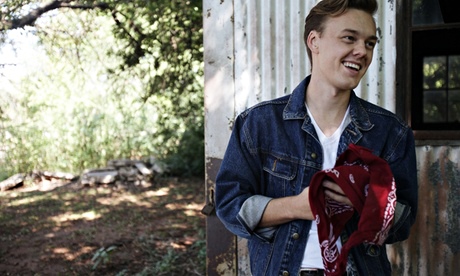January 1976 was as bitter as any winter in Nashville and, as the young New York film-maker Jim Szalapski made his way back north, his camera caught the land’s starkness: snow flurries, icy roads, trailers upturned and cargo spilled. Szalapski had just finished shooting a documentary he would name Heartworn Highways, a profile of a new country scene emerging out of Texas and Tennessee; singer-songwriters such as Guy Clark, Townes Van Zandt, and the young Steve Earle and Rodney Crowell who would become known as proponents of “outlaw country”. Working with a small crew, and even smaller budget, over the course of a few weeks he had caught these musicians playing across liquor-soaked evenings in trailer lots, blacksmiths’ workshops and penitentiaries, attempting to place their music in a cultural landscape.
Ten months later, over Thanksgiving weekend, Martin Scorsese began shooting The Last Waltz, a recording of Canadian-American group the Band’s farewell concert in San Francisco. It featured not only songs by the Band, but also a glut of their musical friends: Bob Dylan, Muddy Waters, Neil Young, Van Morrison, and the Staple Singers among them. In between, Scorsese ran interviews with the group, reflecting on the end of their 16 years on the road.
The Last Waltz was released two years later, and became one of the most revered music documentaries of all time. Heartworn Highways did not surface until 1981, when it played for a week at the Art Cinema on Eighth Street in New York. And though it has garnered a cult following (and a low-key DVD release) in the years since, it has stood somewhat in the shadows. When he died in 2000, Szalapski believed his great labour of love had been a failure. It is interesting to see 1976 as framed by these two films. That year’s US album charts were dominated by [Peter Frampton’s] Frampton Comes Alive, Wings at the Speed of Sound, Their Greatest Hits (1971-1975) by Eagles and Stevie Wonder’s Songs in the Key of Life. Heartworn Highways and The Last Waltz offer something quite different, and helped to spawn the musical genre we have come to know as Americana.
At the time Szalapski began shooting, country music was in the midst of an upheaval. Four years earlier had seen the opening of Opryland, an extravagant theme park that offered rollercoasters and log flumes, and provided a new home for the Grand Ole Opry – the phenomenally popular country music radio show recorded before a studio audience, whose organisers considered themselves the fierce conservators of the country sound.
But country had begun to change: in the early 60s, a folk scene had sprung up in the south, promoting not only contemporary and traditional folk artists but blues greats such as Lightnin’ Hopkins and Mance Lipscomb. By the time Bob Dylan arrived in Nashville to record Blonde on Blonde in early 1966, the first of three albums he recorded in the city, it felt as if the formulaic Nashville country sound was giving way to something more reflective of a traditional heritage, and of the decade’s countercultural movement. In the years that followed, the next generation of country stars drew on these folk and rock influences, as well as honky tonk and rockabilly, and the resulting “outlaw country” movement, led by Waylon Jennings, Willie Nelson and Kris Kristofferson found a ready audience; in 1976 the compilation Wanted! The Outlaws became the first platinum-selling country music album.
“I was not a fan of country music,” says Philip Schopper, who edited Heartworn Highways. “I’m originally from Arizona, and where I grew up and when I grew up, country music represented a frame of mind that I didn’t care for – it was redneck music. In my mind it was associated with prejudice and intolerance and that sort of thing.” Still, he had made a pact with Szalapski some years earlier that if either of them managed to get a film off the ground the other would work on it.
And Szalapski was persuasive. He told Schopper that, “these fellas were writing their own material, and it was a new kind of country music, and they were outlaw musicians in the sense that they were outside the mainstream of country music production at that time”. Szalapski, he recalls, had already made a couple of field trips down to Texas and Tennessee. “He went down with a tape recorder first of all, sat in their homes, their living rooms recording some of the music as they play. The musicians would tend to get together of an evening, playing – pickin’ and grinnin’ as they call it.” He returned to New York enamoured with it, says Schopper: “He would play it for people and say: ‘Listen to this! Something should be done with this!’ And he would try to pitch a film.”
Though he was unsure of the commercial value of such a film, Schopper was soon smitten, too. “What these folks were playing was different. I was drawn to it. I would hear the writing and the skill of musicianship and was really knocked out by it, and the values it was embracing were much closer to hippy values. These songs were about real people and real experiences, and weren’t simply songs about driving your truck, getting drunk and cheating on your girlfriend.”
Szalapski also proved very convincing to a young British art dealer named Graham Leader. The pair had grown friendly over a couple of years, and when Leader found himself with time on his hands he decided to head to Nashville with his director friend to hear the music Szalapski had raved about.
“I just went there on an adventure,” he recalls. “The thing that really captured my imagination was entering this world, a world I would never have stepped into. And being there, in a way, was a revelation and I thought: ‘Who wouldn’t be interested in this music, this world and these people?’ So I asked Jim what it would take to make the film and he gave me a number and I said: ‘OK, let’s just do it.’” Leader signed on as producer, and five weeks later they were filming.
There has been nothing throughout Leader’s career that has given him quite the same satisfaction as Heartworn Highways. “Because of its purity,” he explains, “and the way it was made. Jim was the proverbial fly on the wall, able to get in very close to the subject, whatever the subject. I don’t think the music world is a world that’s wide open, and it’s certainly a distrusting world, but because of his nature and his ability to be sublimated to whatever was going on, he was able to move in very close, and through that find the real depth of colours, of tones, of pictures that you would never ever see, normally.”
Upon the film’s brief release in 1981, the New Yorker ran a three-page review of Heartworn Highways, and while it praised the film highly bemoaning the lack of structure or narration. In truthThat perceived messiness was wholly intentional. “Jim and I used to joke that we were making a content-free documentary,” Schopper laughs. “Meaning we had no agenda, we weren’t out to do a documentary about the music industry or the music business, we were making a film that felt like an experience; you step into it and when you step out of it you feel like you’ve been somewhere and been immersed in something.”
“It was non-narrated, and in those days to have a film that was non-narrated and cuts away from the action to action that was going on elsewhere… [didn’t happen],” Leader explains. “We wanted the whole film to be like a song,” Schopper adds. “Everything had to do with feeling. What feels right to be next, until finally we have something all together that took you along on an emotional and musical trip, and you can come away feeling like you’ve met some people. And not to be overly corny about it, but maybe you’ve met some friends.”
What The Last Waltz had that Heartworn Highways did not was money, famous subjects and a pre-ordained narrative structure. “It came together incredibly quickly,” recalls the film’s producer, Jonathan Taplin. “We just all ran up to San Francisco, brought the best cameramen we knew and literally arrived the night before. In one night, we got 90% of the film. But like any documentary it begins to have an interesting flow to it, and you begin to tell a story, and that was the story both of the Band but also of the music.”
There were hair-raising moments; shooting on 35mm film meant that the magazines had to be changed every 10 minutes, leading to some performances being sacrificed. When Muddy Waters turned up too late to rehearse and announced he would be playing Mannish Boy and Caledonia, Scorsese decided they would change magazines during the first song. “Marty didn’t understand that Mannish Boy was Muddy’s term for I’m a Man,” recalls Taplin. “And at those opening chords of I’m a Man, Marty just went into complete panic, he realised that was the most important song for Muddy and he had told everyone to turn off their cameras.” Only by fluke – one of the cameramen had removed his headphones and therefore had not heard Scorsese’s instruction to stop filming and change the magazine – did the the song get filmed.
For the most part, Taplin remembers the joy of that night – the way “those friends of theirs really raised their performances to the best level possible,” he says. “To me it’s one of the best Van Morrison performances ever. Neil Young was astonishing. I think everybody who was there felt the strength of the moment. There’s a sequence where Eric Clapton’s doing Further on up the Road, and Robbie Robertson takes the second solo, and they were both pushing each other to play at a level that I hadn’t seen either of them play for a while. And there’s a kind of grin going back and forth.” His personal highlight, however, is Levon Helm singing The Night They Drove Old Dixie Down. “For me that’s the kind of elegiac tune that the Band represents, and the film represents. It’s about the end of a time, and obviously the song is about the end of another time, but it has a sad but beautiful we’re gonna somehow still survive mood to it that’s pretty unique.”
The legacy of these two 40-year-old films is tangible. Leader says: “I can be anywhere in the world, at a party or a dinner, and people tell me how much they love that film. I was once in an elevator in Sydney wearing a Heartworn Highways T-shirt, and a young band got in and one of the guys looked at me and said: ‘That’s my favourite film.’It was very special, because it had been in the dark for so long.” Among its many fans are Father John Misty, and Colin Greenwood of Radiohead. An anniversary edition of Heartworn Highways released this year was also accompanied by a sequel, Heartworn Revisited, which focused on contemporary musicians ploughing a similar furrow – among them Justin Townes Earle, Langhorne Slim and Jonny Fritz, with contributions from the players of the original film. Leader now plans to turn Highways into a series.
For Taplin, The Last Waltz “did something to preserve a sense of this roots music” – music with “rough edges” made without aid ofAuto-Tune or Pro-Tools”. He speaks of the young artists, including Mumford & Sons and Sturgill Simpson, who have cite its influence. “I think that next generation of kids that began to make this Americana thing real, that was a touchstone for them. It was a way for them to go back and to think about more simple, grounded music in a time when that wasn’t what was really going on.”
One of those artists is Simone Felice, once of the Felice Brothers, and now a solo performer and producer. “I was born and grew up in the shadow of Big Pink,” he says, meaning the house in West Saugerties in upstate New York where the Band holed up in the late 60s. “We used to ride our bicycles past it as kids … Teleport to 2006. By the greasy hand of fate my brothers and I found ourselves living in an extremely creepy mansion on the Hudson River, writing songs and shooting deer rifles. There was an old TV with a VHS player. We found a tape of The Last Waltz and put it in … Two words: Holy Shit.”
He would later play with Helm, and hear about the darker side of life with the Band, but still he likes to keep the memory of what The Last Waltz inspired safe. “Those nights by the river, watching and learning with my brothers and friends,” he says, “when the music business was still a glittering Oz where songs and dreams collided and not the festering toilet I’ve come to know – the unfettered spirit of music flowed from those men and women on the TV as from some wild, legendary river in a Steinbeck novel. That’s what I’ll choose to take away. That’s what I’ll choose to carry.”
The legend that The Last Waltz helped to instill, remains part of the Band and their contemporaries’ appeal. “The Band are the ultimate exponents of the melting pot that is Americana,” says Barney Hoskyns, author of Small Town Talk: Bob Dylan, The Band, Van Morrison, Janis Joplin, Jimi Hendrix and Friends in the Wild Years of Woodstock. “They’re the band cited by all the innumerable acts that mine that seam. You could probably say 5,000 bands since who have wanted to be the Band, though they’re not as talented or as steeped in music and they’re middle-class pretenders. But that’s the fantasy to life in Big Pink.
“Did they create Americana at Big Pink?” he asks. “Probably. That is music taken from every element of American roots. It’s neither black nor white. It’s rural but not entirely rural. It’s southern but not entirely. It’s soulful, it’s bluesy, it’s folksy. It’s got gospel in there, but rock’n’roll elements there, too. What would you have called it then? So it began a strain of retromania, of pulling away from the contemporary moment and retreating into some sort of cocoon of authenticity. Which, of course, isn’t authentic at all.”
Forty years on – whether through a shared retromania or a celebration of songwriting prowess and the countercultural voice – these two films do seem to speak to one another. They portray a time in 1976 when a group of musicians were helping to define one of the US’s distinct musical voices. “Those roots of Americana go deep,” says Hoskyns, “and if we look at the musical tree, then I’d say The Last Waltz and Heartworn Highways are branches of the same tree.”
• The soundtrack to Heartworn Highways is out now on Light in the Attic









